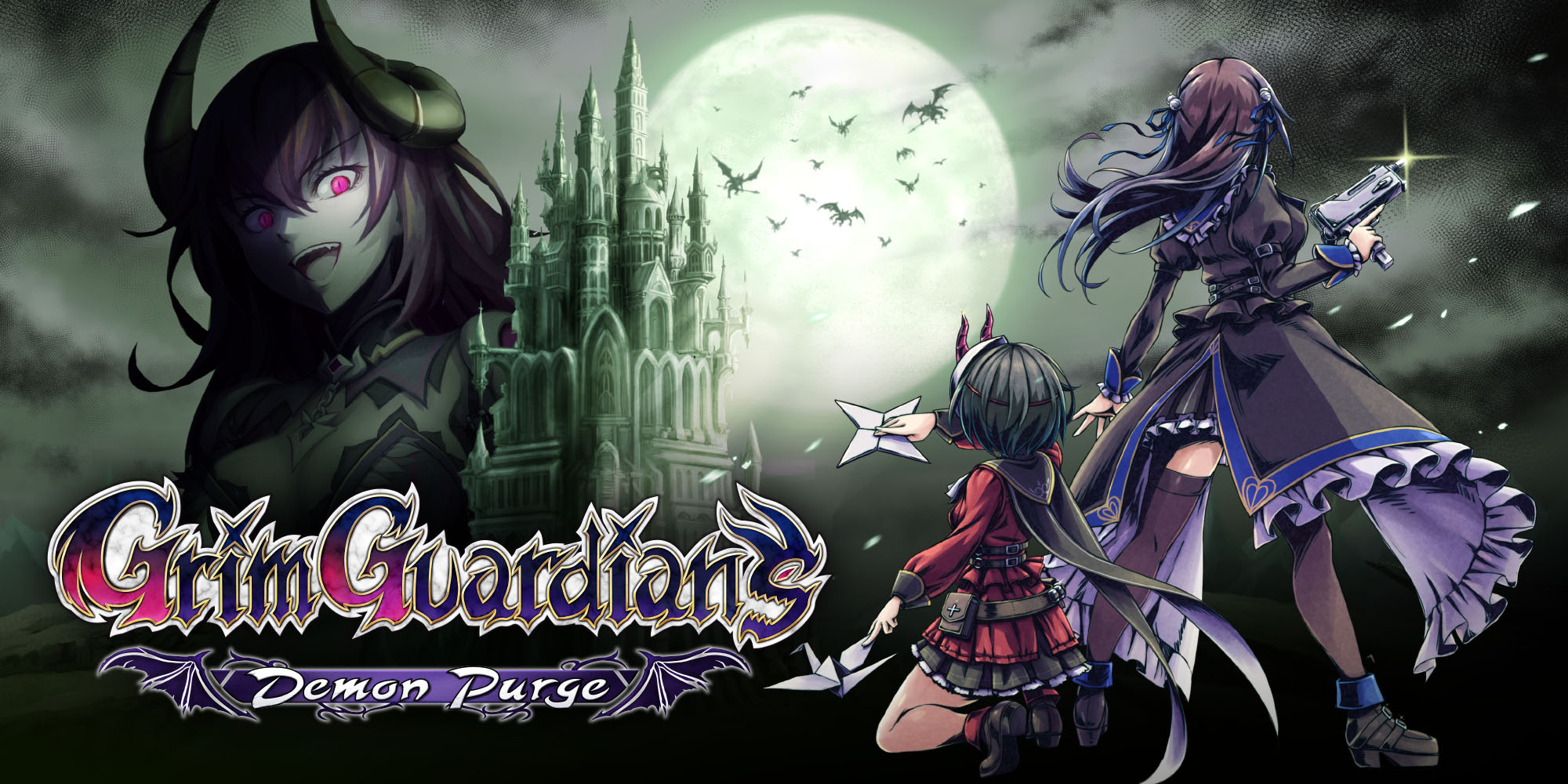Grim Guardians: Demon Purge is a spin-off from the notoriously raunchy series Gal*Gun. I wasn’t initially aware of the origins prior to reviewing this title, so you can imagine my surprise as to what this game goes for in its contents. The TLDR of Gal*Gun is that it’s a rail shooter where you play seemingly the only boy in Sakurazaki Academy firing ‘Pheromone Arrows’ to dispel all the girls professing their love for you. Now, that doesn’t sound like my cup of tea, but each to their own.
The fascination of those – shall we say – aspects of anime are not something I could ever subscribe to. With that said, Grim Guardians: Demon Purge on the surface didn’t look like that at all. I saw a 2D-Pixel Art Metroidvania with a unique character swap mechanic that looked frenetic. And for the most part, it kind of delivered on that? Let’s get into it.
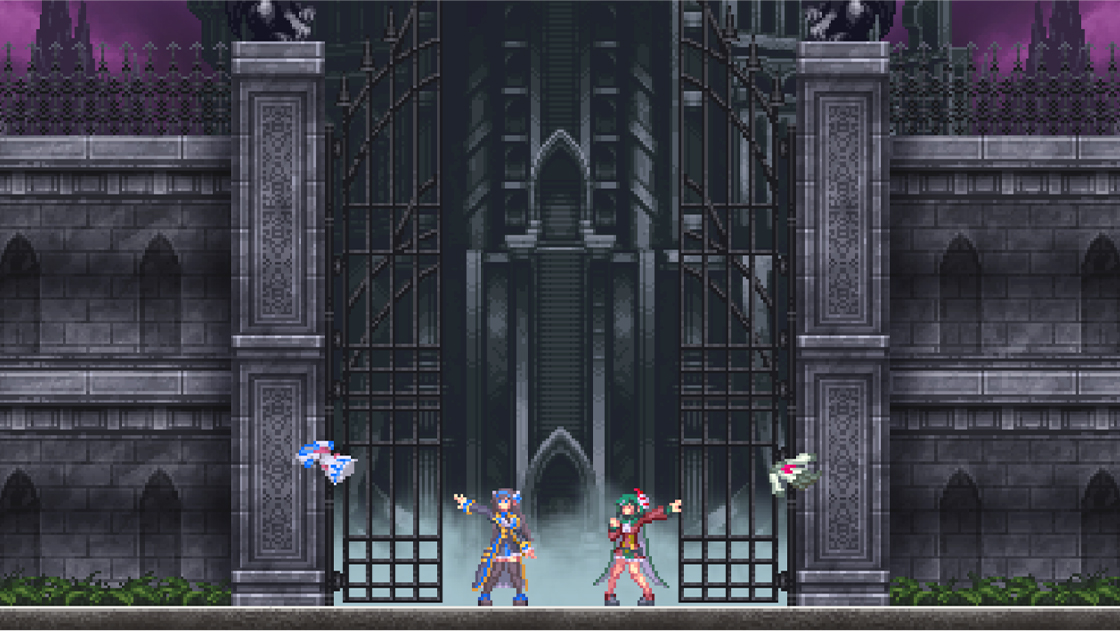
That’s What I Go To School For
Demon slaying sisters Shinobu and Maya Kamizono are on their way to Sakurazaki Academy. That is until a mysterious mirror transports them to a dimension turning the academy into a castle from hell. Thankfully for the Kamizono sisters, this is just a normal Monday and they throw off their short school skirts for… Even shorter demon hunter skirts. The mastermind behind this is Gal*Gun 2 antagonist – Kurona. Having been held back a year at Demon Academy, she wanted to play a prank on the sisters, hence the whole school being sent to hell. The Kamizono sisters must go through the castle to defeat Kurona and bring the Academy back from hell – by way of killing everything and saving schoolgirls along the way.
Story beats are sparse between the gameplay which is fine as it lets the action take the front seat. By the end credits I’m not entirely sure if the game is self-aware of its own perversion or if it’s blissfully ignorant enough to give the impression. Either way I couldn’t help but meet the dialogue with an eye roll which quickly turned into skipping it all together. Outside of that, the game is voice acted in either English or Japanese, but I hope you like what the sisters have to say because you’ll hear it a lot. “Take this!”, “No Escape!” and a few other such phrases are their only lexicon. Each voice bite is tied to an attack so if you favour a move (which you will), you’ll be hearing it a lot – unless you mute the TV.
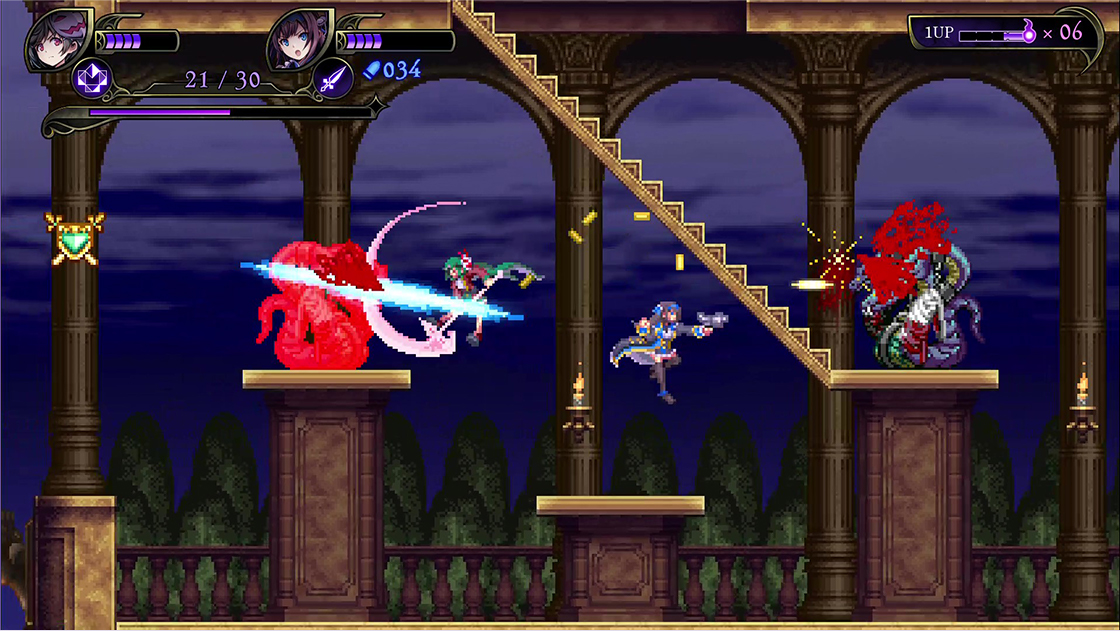
Castle-Who?
If you’re playing solo, you’ll be in control of both Maya and Shinobu. You can switch between them at any time with the L2 and R2 buttons. This stops time for the animation to proceed. Maya has a sword and uses the art of Shikigami for melee based attacks. Shinobu has an anti-demon sub-machine gun for long-ranged attacks. Each of them also come with their own subweapons. These are unlocked through beating the bosses in the story. Shinobu has more of an explosive arsenal, with a rocket launcher, mines and grenades; whereas Maya has various Shikigami that could freeze, burn and even a paper crane to use as a platform.
Maya’s paper crane doesn’t nearly come as handy as Shinobu’s grappling hook to reach those secret areas in the stages. I didn’t use the subweapons too often, probably to my detriment, however I never saw the usefulness when in combat outside of using both sister’s main attacks. For context, I played on Casual. At the start there are two difficulties Casual and Veteran. Casual means there’s no knockback when being hit and infinite lives if you need to respawn. Veteran just means the opposite, which in-turn gives it the more authentic feel of a 90’s action platformer.
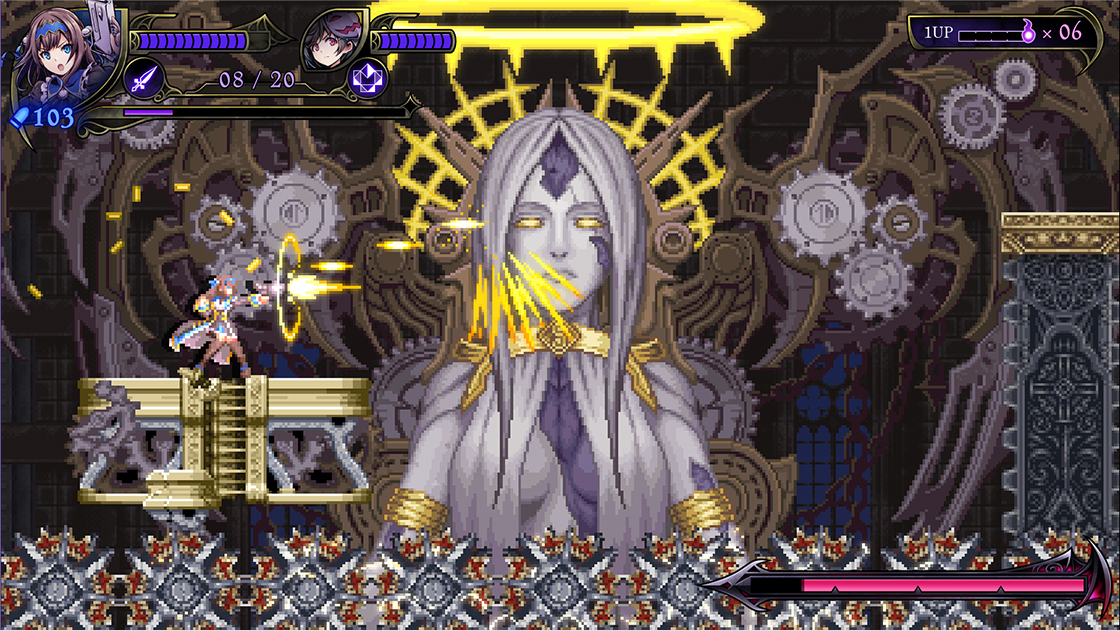
Metroid-What?
The combat itself is a delight – it’s what carried me through to the end. The pixel blood smattering the walls as you slice through demons is endlessly satisfying with its responsiveness. The cohesion between swapping characters mid-battle just made you feel like a badass. However, it can be easily exploitable by just catching an arm from an enemy on the edge of the screen and blasting away till they were dead. On top of that, there’s also a mechanic that if one of sisters goes down, you’ll start at the nearest checkpoint to revive them where they fell in battle.
On paper it’s a unique and interesting mechanic that gives you one more chance. With that said, it makes bosses so easy to exploit as their health only increases a little bit when you come back into the fight to revive your sister. This leads to a rinse and repeat until you’re done. Whilst I appreciated this because I didn’t like the other aspects as much, if this was a stronger game it’d feel lacklustre. Calling it a Metroidvania is certainly a polite term. The game is broken up into stages, and at the end of every stage is a teleporter that can send you back. This means if you want to try out your power on that secret room, you’ll have to play through that stage and teleport back to the start of a chosen stage.

Not My ‘Vania
Without a map and only a compass that is useful for seeking the boss room, you’ll be going through whole levels trying to remember where that one door was. To add insult to injury for myself – a chronic backtracker – I would often replay levels when I gained a power from a boss, only for the game to send me back through all the levels after I thought I had beaten the game. Thus rendering all the backtracking I did the first time pointless, as I was doing it all again with the full arsenal anyway. To me, that doesn’t make a Metroidvania. It’s an arcade action that mimics one.
The worst part is, the second time round is much more enjoyable. After a solid 8 hours of playing and replaying stages, the second half opens up. More characters, more variety in your base attacks, everywhere is explorable. Why wasn’t this the game from the start? The choice in this design is dumbfounding. On top of that, the baseline form of platforming isn’t the finest. My jumps would often not register at the end of platforms resulting in a lot of pitfalls. This meant backtracking to revive or just restarting. Some of the secrets are even in pitfalls, but who wants to try if you’re dead immediately. It just made seeking out the secrets tedious, especially when there’s no map indicating potential rooms/connections either.
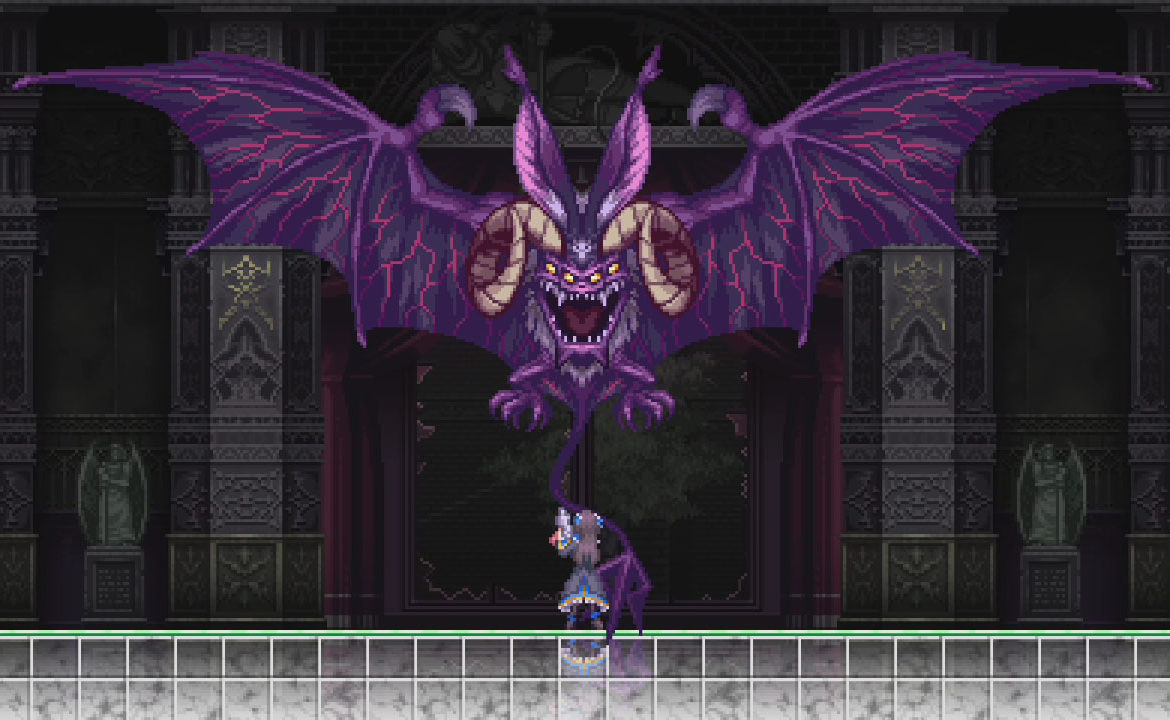
From Who The Bell Tolls
Despite having a few handfuls of gripes with the gameplay, it is at least a visual treat. The Kamizono sisters themselves when they’re getting the 16-Bit treatment look so busy their sprite just blurs. However, everything else from the enemy designs, levels and bosses are so stylistically ghoulish and varied. It was a visual marvel every time I was faced with a new boss. Some take larger cues from Castelvania than others, but they all stand out as being incredibly well put together. This coupled with all the animations for the attack made it an overall stunning experience.
The music accompanying it also elevates the Castlevania tone. Pianos and organs blister through the action in true Gothic fashion. Though there is only the one main theme you hear during your playthrough, it never gets old to the point of needing to turn the volume down, unlike the voice lines.
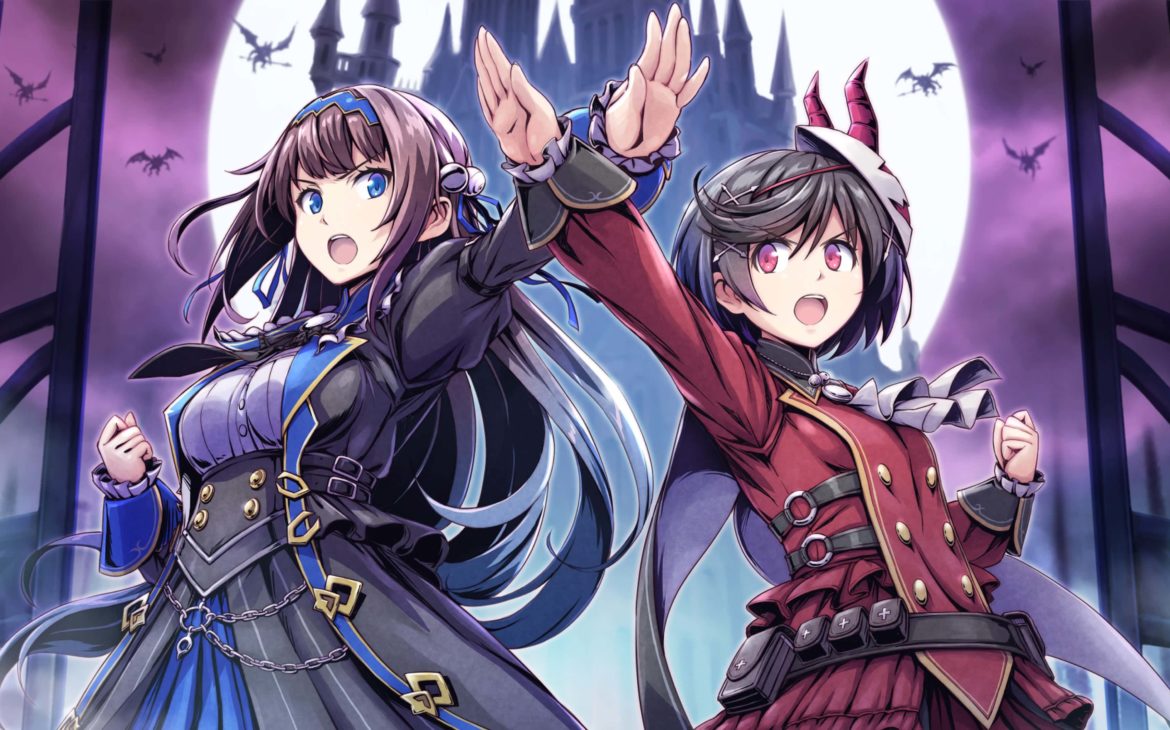
School’s Out For Hell
Overall, I’ve come away with mixed feelings for Grim Guardians: Demon Purge. On the one hand the action is an entertaining, concise and I’d even go as far to say one of the better combat systems in the genre. On the other hand, I didn’t get on with pretty much everything else the game has to offer. I’d like to mention that the game does also include a 2 player co-op with Boss Rush Mode, and a harder difficulty once you beat the game. It definitely adds to the value, but it’s not something I’d replay through.
Grim Guardians: Demon Purge is flawed in a lot of the ways it sells itself on. As a Metroidvania, it’s a really weak attempt, but as an Arcade Action Platformer it’s astounding. It just didn’t lean into one or the other enough. If you’re not a fan of Gal*Gun, most of it will go over your head, but fans may love this. Though as an entire package it just does okay.

Grim Guardians: Demon Purge is out now on PlayStation 5 (review platform), PS4, Xbox One, Xbox Series S|X, Nintendo Switch and PC (Steam)
Developer: Inti Creates
Publisher: PQube
Disclaimer: In order to complete this review, we were provided with a promotional code from the publisher. For our full review policy, please go here.
If you enjoyed this article or any more of our content, please consider our Patreon.
Make sure to follow Finger Guns on our social channels. Twitter, Facebook, Twitch, Spotify or Apple Podcasts – to keep up to date on our news, reviews and features.
